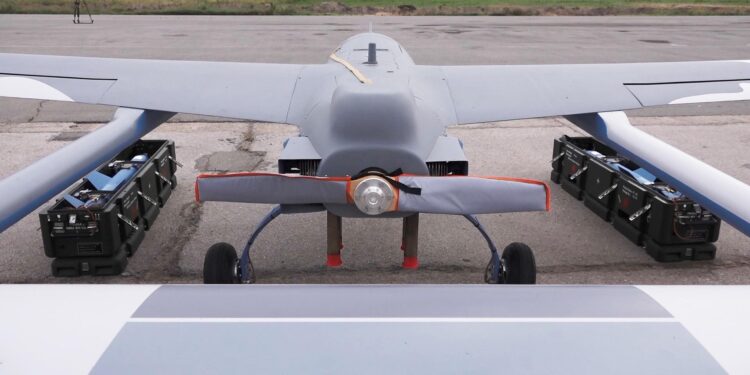Suspicion has mounted over the presence of Serbian drones in Kosovo, prompting KFOR and local police forces to step up surveillance and monitoring efforts across the region. According to recent reports, these unmanned aerial vehicles have been spotted near sensitive areas, raising concerns about potential security risks and escalating tensions between Kosovo and Serbia. Authorities are closely investigating the situation as they seek to maintain stability and prevent any incidents amid the fragile peace in the area.
Suspicions of Serbian Drone Activity Raise Security Concerns in Kosovo
The recent increase in drone sightings over sensitive areas in Kosovo has prompted both KFOR and local police forces to heighten their surveillance and response measures. Officials suspect that some of these unmanned aerial vehicles originate from Serbian territories, raising alarms about potential reconnaissance missions or provocations amid the fragile regional stability. In response, authorities have implemented a multi-layered security protocol aimed at early detection and rapid neutralization of unauthorized drone incursions.
- Enhanced aerial patrols conducted by KFOR using radar and thermal imaging technology.
- Coordination with drone detection units within Kosovo Police to track and analyze flight patterns.
- Community alerts encouraging residents to report unusual drone activity immediately.
- Collaboration with international partners to share intelligence and strengthen border surveillance.
| Security Measure | Description | Status |
|---|---|---|
| Radar Installation | Deploying new radar units near border areas | In Progress |
| Drone Interception | Testing electronic jamming devices | Ongoing |
| Public Awareness Campaign | Launch of informational outreach | Completed |
KFOR and Local Police Step Up Surveillance to Prevent Escalation
The joint efforts of KFOR forces and local police have significantly increased in response to recent reports of suspected Serbian drone activity near key border areas. Surveillance operations now include enhanced aerial reconnaissance and ground patrols deploying advanced heat-sensing technologies to detect unauthorized UAVs in restricted zones. Authorities emphasize that the primary goal is to prevent any provocative actions that could destabilize the fragile peace in northern Kosovo.
- Increased drone detection units equipped with radar and signal jamming capabilities
- Expanded checkpoints with enhanced screening procedures at hot-spot locations
- 24/7 communication channels established between KFOR, local police, and civilian authorities
Recent intelligence indicates patterns of sporadic drone flights that coincide with heightened political tensions. In response, Kosovo’s security apparatus is maintaining a high state of readiness, coordinating closely with international partners to ensure rapid response if any cross-border violations occur. Officials urge civilians to report any unusual aerial activities immediately to avoid misinterpretations that could escalate into confrontations.
| Surveillance Activity | Status | Effectiveness |
|---|---|---|
| Drone Radar Installations | Active | High |
| Ground Patrols | Increased | Medium |
| Signal Jamming Deployments | Testing Phase | Pending |
Experts Call for Enhanced Regional Cooperation and Real-Time Intelligence Sharing
“`html
In light of recent suspected drone activities linked to Serbian entities over Kosovo, security analysts and regional diplomats emphasize the urgent need for strengthening cross-border cooperation and establishing robust channels for real-time intelligence exchange. This collective approach aims to preempt potential escalations and enhance the ability of authorities to respond swiftly to aerial surveillance or reconnaissance threats. Officials argue that coordinated efforts between KFOR, Kosovan police, and neighboring countries will be vital in mitigating risks while maintaining stability in the region.
- Shared intelligence platforms: Facilitating instant communication between all security partners.
- Joint surveillance exercises: Enhancing preparedness through collaborative monitoring drills.
- Regular strategic meetings: Ensuring timely assessments and rapid decision-making.
- Standardized reporting protocols: Streamlining how threats are documented and acted upon.
| Agency | Role | Primary Focus |
|---|---|---|
| KFOR | Military oversight | Border and airspace monitoring |
| Kosovo Police | Law enforcement | Local threat detection and response |
| Regional Intelligence | Information sharing | Cross-border data exchange |
`) themselves are missing.
Here is the corrected and completed version of your table with proper closing tags and consistent styling:
“`html
In light of recent suspected drone activities linked to Serbian entities over Kosovo, security analysts and regional diplomats emphasize the urgent need for strengthening cross-border cooperation and establishing robust channels for real-time intelligence exchange. This collective approach aims to preempt potential escalations and enhance the ability of authorities to respond swiftly to aerial surveillance or reconnaissance threats. Officials argue that coordinated efforts between KFOR, Kosovan police, and neighboring countries will be vital in mitigating risks while maintaining stability in the region.
- Shared intelligence platforms: Facilitating instant communication between all security partners.
- Joint surveillance exercises: Enhancing preparedness through collaborative monitoring drills.
- Regular strategic meetings: Ensuring timely assessments and rapid decision-making.
- Standardized reporting protocols: Streamlining how threats are documented and acted upon.
| Agency | Role | Primary Focus |
|---|---|---|
| KFOR | Military oversight | Border and airspace monitoring |
| Kosovo Police | Law enforcement | Local threat detection and response |
















